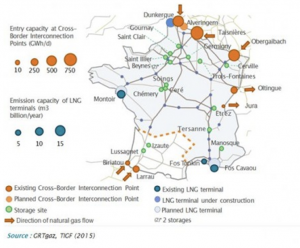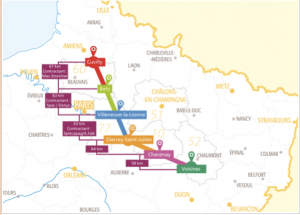October 2016, Vol. 243, No. 10
Features
French Pipeline Strategy Moves Ahead

France is the fourth-largest gas market in Europe, consuming 50 Bcm, which is about 10% of EU demand. France is heavily dependent on gas imports, with 30% of those arrives by tanker as LNG and the remaining 70% as piped in. The imports come from five European countries, via gas interconnectors, according to Eurostat 2016.
The French transmission network is the longest in Europe, dominated by just two companies: GRTgaz, which transmits gas from three northern interconnectors to the western, northern and southern regions and TIGF, which transmits gas arriving through two southern interconnectors to the southwestern region adjoining the border with Andorra and Spain (Figure 1).
Figure 1: The French gas network.
Market Trends
The onset of declining demand for gas from the power sector began in 2010 with a drop of about a third coming in 2014 to bring the decline over the previous three years to over 60%. Additionally, gas demand by the industrial sector fell over 6% in 2014.
These significant declines can be attributed primarily to the poor performance of the French economy, the growth in the use of renewables and the impact of improved energy efficiency measures, causing overall demand in the GRTgaz zone to fall by 390 TWh (Terra Watt hours) or 5.4% between 2014-15.
GRTgaz Pipelines
GRTgaz, a subsidiary of French energy giant Engie (formerly Gulf De Suez), with 32,320 km of pipelines, is the country’s largest gas pipeline operator by size of network, turnover and number of industrial and distribution customers. With 2015 turnover of €1,956 and profits of €341 million, it delivered the equivalent of 589.9 TWh to 1,021 industrial customers that took 154.6 TWh, with the remainder going to 3,390 distribution customers that, in turn, supply gas to households, according to GRTgaz (Table 1).
In the same year GRTgaz spent €287 million on maintenance and €337 million on expansion of its network. In addition to its French operations, GRTgaz has operating interests in southern German networks.
Table 1: French gas imports and network infrastructure as of March.
Sources: TIGF, GRTgaz, European Energy Markets Observatory
TIGF
TIGF, with only 5,000 km of pipelines, is the country’s second-largest operator. Since 2013, it has been owned by a consortium of Snam, the Italian gas transport and storage operator (45%); GIC, the Singaporean sovereign fund (35%); and EDF (20%). In 2014, TGIF’s turnover was €419 million and its investments of €135 million included €10 million on safety measures, according the company website.
In the same year, TIGF transmitted 16% of the country’s gas to about 120 industrial customers on behalf of gas shippers. In addition, it has gas storage capacity of 30 TWh, or 23% of the country’s total, and 11 storage customers (Table 1). In contrast to GRTgaz, TIGF’s main markets lie in the southwest, especially in the cities of Bordeaux, Toulouse and Perpignan. TIGF also acts as a transit market for gas traded between Northern Europe and the Iberian Peninsula.
Pipeline Developments
Under the auspices of the EU’s efforts to improve flexibility of the European gas market, current developments primarily target increased capacity of the domestic network and additional cross-border transport of gas between neighboring states, thereby facilitating gas trading.
Major Pipeline Projects
In the south of France, the plan is to build MIDCAT, the 190-km, 36-inch pipeline. This joint project between Spanish gas system operator Enagas and French operator TIGF is taking shape and will cross the Pyrenees mountains to connect with Spain’s northeast gas network, bringing Algerian gas to France and onward to Germany, Switzerland and Italy. GRTgaz plans to upgrade the capacity of its gas grid.
Algeria has long supplied Spain with gas via two established underused trans-Mediterranean subsea pipelines: the 12 Bcm/y Maghreb-Europe Gas Pipeline and the 8 Bcm/y Medgaz. MIDCAT will transport additional imports of gas to supply Spain’s 8 Bcm/y LNG import terminals, according to European news outlet Euroactiv.com.
However, the importance of MIDCAT extends beyond the markets of Spain and France. According to Antoni Peris, chairman of the Sedigas Gas Industry Association, “Spain’s MIDCAT pipeline could replace 10% of (Europe’s) Russian gas imports.”
Despite EU support for the $1.13 billion MIDCAT project, progress has been slow due to lack of enthusiasm from the French government. Nevertheless, according to EU Commissioner for Energy and Climate Action Miguel Arias Cañete, MIDCAT will be built by 2020. Natural Gas Europe, however, is not as confident and suggests 2022 is the more likely start date for operations. Upon its eventual completion, MIDCAT will allow Spain to become an alternative gas hub for markets in northwest Europe.
With an expected completion date at the end of this year, the $866 million Arc de Dierrey gas pipeline will improve links between the French LNG import terminal at Dunkerque and markets in southern France and further afield in Germany, Switzerland and Italy. The 300-km pipeline is being constructed by grid operator GRTgaz and should significantly improve transit capacity to southern France, where additional gas supplies are needed to feed nine gas plants scheduled over the next decade, as well as increase supplies to 12 existing plants operated by EDF and ENERGIE.
Russian gas supplies comprise only 10-15% of French needs, and Olivier Aubert, head of supply at GRTgaz, said this shows France could cope without Russian gas, except in the case of extremely low temperatures, which are seen about every 50 years. This new pipeline will provide Germany with a strategic alternative to Russian gas, namely U.S. LNG. Germany, which relies on Russia for 36% of its gas imports, does not have direct access to a LNG terminal of its own, although two terminals, one in Belgium and one in the Netherlands, can supply Germany (Figure 2).
Figure 2: The Arc de Dierrey pipeline.
However, in order to meet Germany’s gas detection requirements, French operators will have to adapt their odorization process. In France, the smelly liquid is added to the natural gas distribution system centrally at gas hubs, but in Germany and in most other European countries, odors are added at stations outside of each city. GRTgaz is experimenting with its odorization process in order to meet German requirements.
The 900-km GALSI pipeline project concept was launched in 2005. It will link the giant gas field of Hassi R’mel in Algeria to northern Italy via the Italian island of Sardinia, from where the Cyrénée pipeline will run offshore to the French island of Corsica to supply the Vazzio and Lucciana power plants.
This French link should reduce electricity costs by 30-40%, providing a significant boost to Corsica’s economy and specifically benefiting its high-energy users. Despite support from Paris, the Cyrénée project, along with the €3.41 billion GALSI, awaits final agreement between Algeria and Italy.
Times have changed since 2005, and given the flatness of Italian demand for gas, the under-utilized Trans-Mediterranean Pipeline, which links Algeria with Italy via Sicily, and the prospects of new gas arriving in Italy from Central Asia in 2020 when the Trans Adriatic Pipeline opens, there seems to be little urgency to move matters forward.








Comments